If you’re looking for a quick, healthy, and flavorful meal, this vegetable stir-fry for dinner is the perfect choice. Packed with fresh, colorful vegetables and a savory homemade sauce, this dish comes together in under 20 minutes, making it ideal for busy weeknights. Whether you’re cooking for one or feeding a family, this easy stir-fry is both nutrient-rich and satisfying.
Print
Vegetable Stir-Fry for Dinner
- Total Time: 20 minutes
- Yield: 4 servings
- Diet: Vegan
Description
This vegetable stir-fry for dinner is a quick, healthy, and flavorful meal loaded with fresh, colorful vegetables and tossed in a savory homemade stir-fry sauce. It’s ready in under 20 minutes and can be customized with your favorite protein, making it a perfect weeknight dinner. Whether served over rice or noodles, this dish is packed with crisp textures, bold flavors, and essential nutrients for a satisfying and nutritious meal.
Ingredients
For the Stir-Fry:
- 1 tablespoon peanut oil (or avocado oil)
- 1 cup broccoli florets
- 1 medium red bell pepper, sliced
- 1 medium yellow bell pepper, sliced
- 1 medium carrot, thinly sliced
- ½ cup snap peas or snow peas
- ½ cup mushrooms, sliced
- ¼ cup green onions, chopped (for garnish)
- 1 teaspoon sesame seeds (for garnish)
For the Stir-Fry Sauce:
- 3 tablespoons soy sauce (or tamari for gluten-free)
- 1 tablespoon sesame oil (for flavor, not cooking)
- 1 tablespoon rice vinegar
- 1 tablespoon honey or maple syrup
- 1 teaspoon cornstarch (to thicken the sauce)
- 2 cloves garlic, minced
- 1 teaspoon fresh ginger, grated
- ½ teaspoon red pepper flakes (optional, for spice)
Optional Protein Additions:
- 1 cup tofu, cubed and pan-fried
- 1 cup chicken breast, thinly sliced
- 1 cup shrimp, peeled and deveined
Instructions
Step 1: Prep the Ingredients
- Wash and chop all vegetables into even bite-sized pieces for uniform cooking.
- Mince the garlic, grate the ginger, and mix all sauce ingredients in a small bowl.
Step 2: Heat the Pan
- Heat a wok or large skillet over medium-high heat for about 1-2 minutes.
- Add the peanut oil and swirl to coat the pan.
Step 3: Cook the Protein (If Using)
- If adding chicken, tofu, or shrimp, cook it first.
- Stir-fry for 3-4 minutes until fully cooked, then remove and set aside.
Step 4: Stir-Fry the Vegetables
- Add garlic and ginger and stir-fry for 30 seconds until fragrant.
- Toss in broccoli, carrots, and bell peppers and stir-fry for 3 minutes.
- Add snap peas and mushrooms, cooking for another 2 minutes.
Step 5: Add the Sauce
- Pour the stir-fry sauce over the vegetables and stir well.
- Let the sauce thicken for 1-2 minutes, ensuring all ingredients are coated.
Step 6: Finish and Serve
- Return any cooked protein to the pan and mix well.
- Turn off the heat and drizzle sesame oil for added depth.
- Garnish with green onions and sesame seeds before serving.
Step 7: Serve Immediately
- Enjoy over steamed rice, brown rice, quinoa, or noodles for a complete meal.
Notes
- For a low-carb option, serve with cauliflower rice.
- For extra spice, add more red pepper flakes or sriracha.
- For a nutty crunch, top with crushed peanuts or cashews.
- To store, keep in an airtight container in the fridge for up to 4 days.
- Prep Time: 10 minutes
- Cook Time: 10 minutes
- Category: Main Dish
- Method: Stir-Fry
- Cuisine: Asian-Inspired
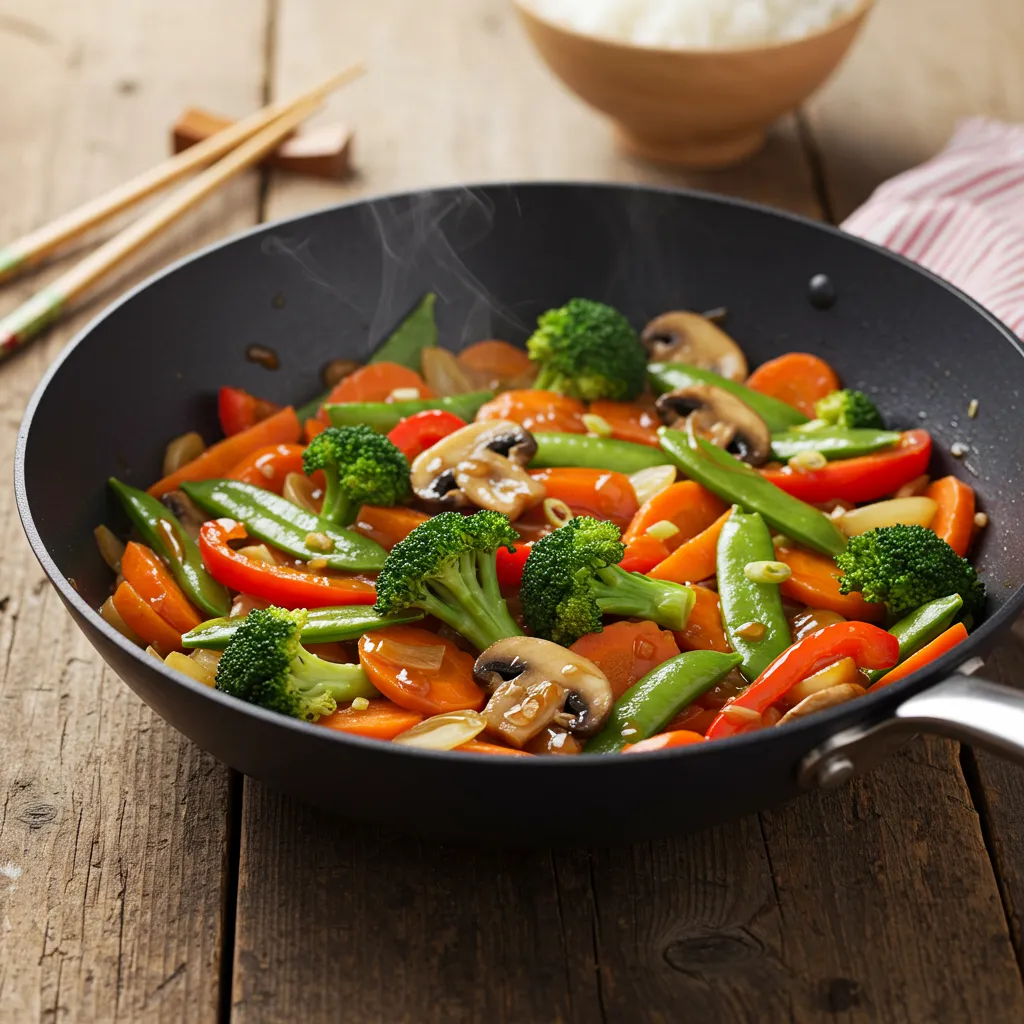
With crisp-tender vegetables, bold aromatics, and endless customization options, this recipe stands out as a delicious, versatile, and wholesome meal. Let’s dive into why this stir-fry is a must-try!
What makes this recipe stand out?
- Fast and easy: Perfect for busy weeknights.
- Nutrient-rich: Loaded with vitamins, fiber, and antioxidants.
- Versatile: Works with any vegetables or protein of your choice.
- Light yet satisfying: A great alternative to heavy meals.
The secret to a great stir-fry lies in the technique. Cooking at high heat keeps the vegetables crisp, while a savory sauce ties everything together. With a few essential tips, you’ll be able to make a restaurant-quality stir-fry right in your own kitchen.
This recipe is more than just a quick dinner—it’s a delicious, foolproof way to enjoy fresh ingredients while keeping meals exciting and wholesome. Let’s get started!
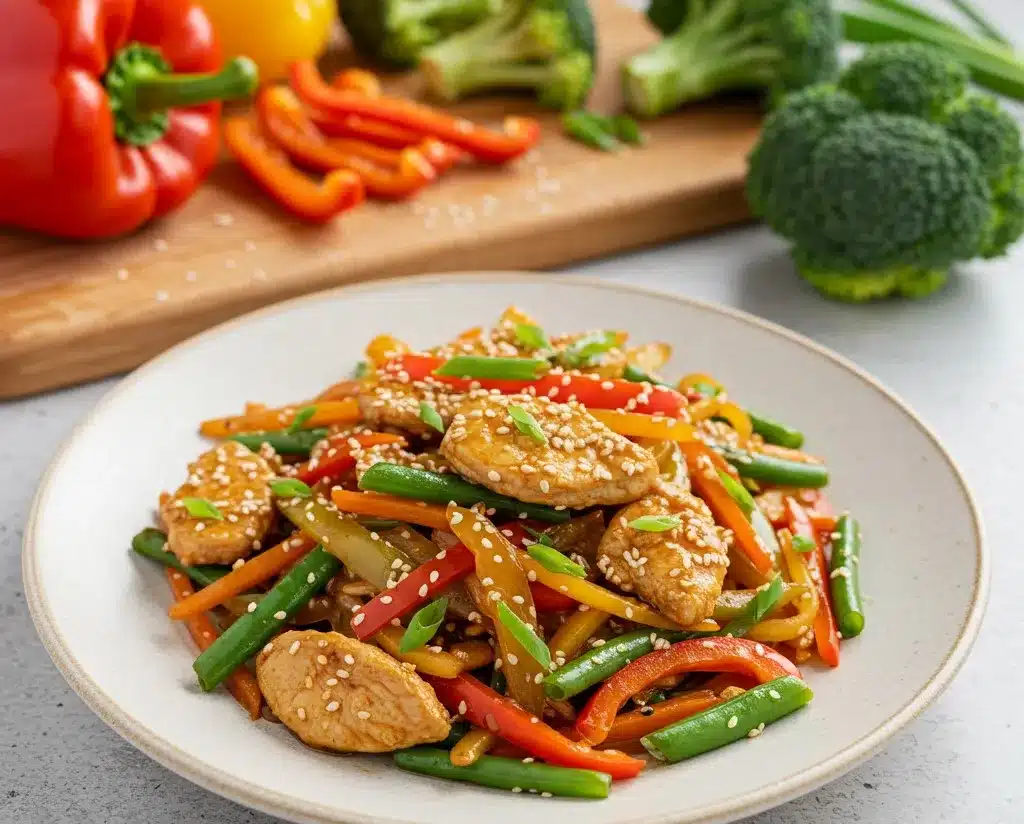
Why You’ll Love This Vegetable Stir-Fry for Dinner
A vegetable stir-fry is more than just a quick dinner—it’s a flavorful, nutrient-rich meal that fits into any lifestyle. Whether you’re looking for a healthy weeknight dinner or a versatile dish for meal prep, this recipe delivers. Here’s why this belongs in your kitchen lineup.
1. Quick and Easy to Make
This stir-fry comes together in under 20 minutes, making it perfect for busy schedules. With minimal prep and simple cooking techniques, you’ll have a delicious meal on the table in no time.
2. Packed with Nutrients
Stir-frying preserves essential vitamins, fiber, and antioxidants, ensuring you get the most from your meal. Ingredients like broccoli, bell peppers, and carrots are loaded with nutrients that support overall health. Learn more about the benefits of eating fresh vegetables from EatingWell.
3. Customizable to Your Taste
What makes stir-fry truly great is how adaptable it is. You can use whatever vegetables you have on hand or adjust the flavors to suit your preferences. Want more protein? Add tofu, chicken, or shrimp. Need extra spice? A dash of chili flakes or sriracha will do the trick. For expert stir-frying tips and meal inspiration, check out Bon Appétit.
4. Perfect for Any Diet
This stir-fry is naturally vegan and gluten-free, but it can be easily adapted to fit different diets:
- Keto-friendly: Skip cornstarch and use low-carb vegetables like zucchini and mushrooms.
- High-protein: Add grilled chicken, shrimp, or tempeh for extra protein.
- Going soy-free? Coconut aminos work well as a soy sauce alternative.
5. A Family Favorite
With its vibrant colors, crisp textures, and bold flavors, this dish is sure to be a hit with both kids and adults. Pair it with steamed rice, quinoa, or noodles for a complete meal that everyone will enjoy.
This vegetable stir-fry isn’t just a recipe—it’s a kitchen staple that makes eating healthy effortless. Up next, let’s go over the ingredients you’ll need to bring this dish to life.
Fresh Ingredients for the Best Vegetable Stir-Fry
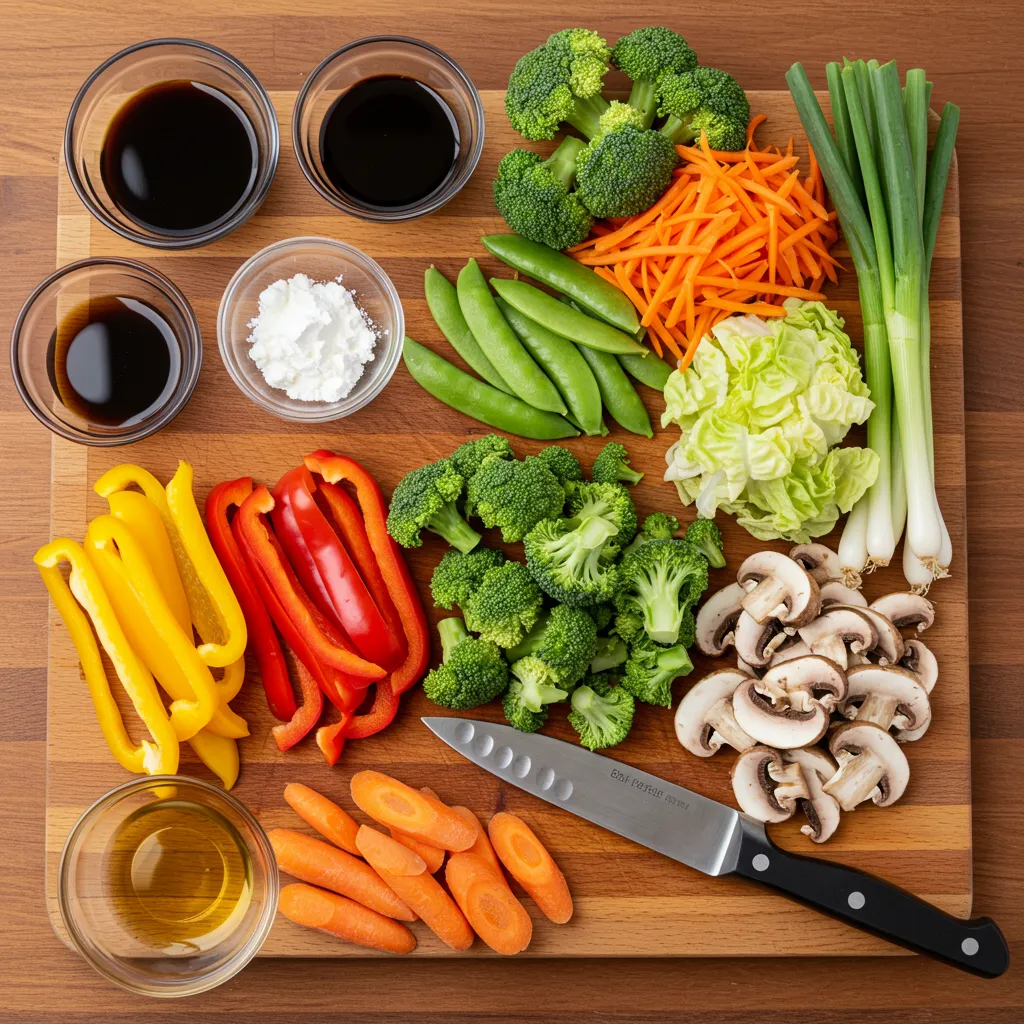
A great vegetable stir-fry starts with fresh, vibrant ingredients. This recipe is all about color, texture, and flavor, so choosing the right vegetables and seasonings makes all the difference. Below is a breakdown of everything you need to make this dish delicious and satisfying.
1. Fresh Vegetables
For the best results, select a variety of crisp, colorful vegetables that cook quickly and complement each other. Here are some great options:
- Broccoli florets – Adds a hearty bite and soaks up sauce well.
- Bell peppers (red, yellow, or green) – Sweet and crunchy, perfect for contrast.
- Carrots – Brings a touch of natural sweetness and texture.
- Snow peas or snap peas – Crisp and refreshing, adding a fresh pop to every bite.
- Zucchini – Softens slightly while still holding its shape.
- Mushrooms – Absorb the flavors of the stir-fry sauce beautifully.
- Onion (red or yellow) – Enhances the dish with a slightly caramelized sweetness.
Use whatever veggies you have on hand—just be sure to chop them evenly so they cook at the same rate.
2. Aromatics and Flavor Boosters
The secret to an authentic, restaurant-quality stir-fry lies in the aromatics. These ingredients enhance depth and fragrance:
- Garlic (2-3 cloves, minced) – Essential for bold, savory flavor.
- Ginger (1-inch piece, grated) – Adds a warm, slightly spicy kick.
- Green onions (chopped, for garnish) – Brightens up the dish with freshness.
- Red pepper flakes (optional) – For those who love a little heat.
3. The Stir-Fry Sauce
A well-balanced sauce brings all the ingredients together. Here’s a simple but flavorful mix:
- 3 tablespoons soy sauce (or tamari for gluten-free) – The salty, umami base.
- 1 tablespoon sesame oil – Adds a deep, nutty aroma.
- 1 tablespoon rice vinegar – Brings acidity to balance flavors.
- 1 tablespoon honey or maple syrup – Just a touch of sweetness.
- 1 teaspoon cornstarch – Helps the sauce thicken and coat the vegetables.
- ½ teaspoon sriracha or chili paste (optional) – For extra spice.
Simply whisk these together in a bowl before adding them to the pan.
4. Protein Additions (Optional but Recommended)
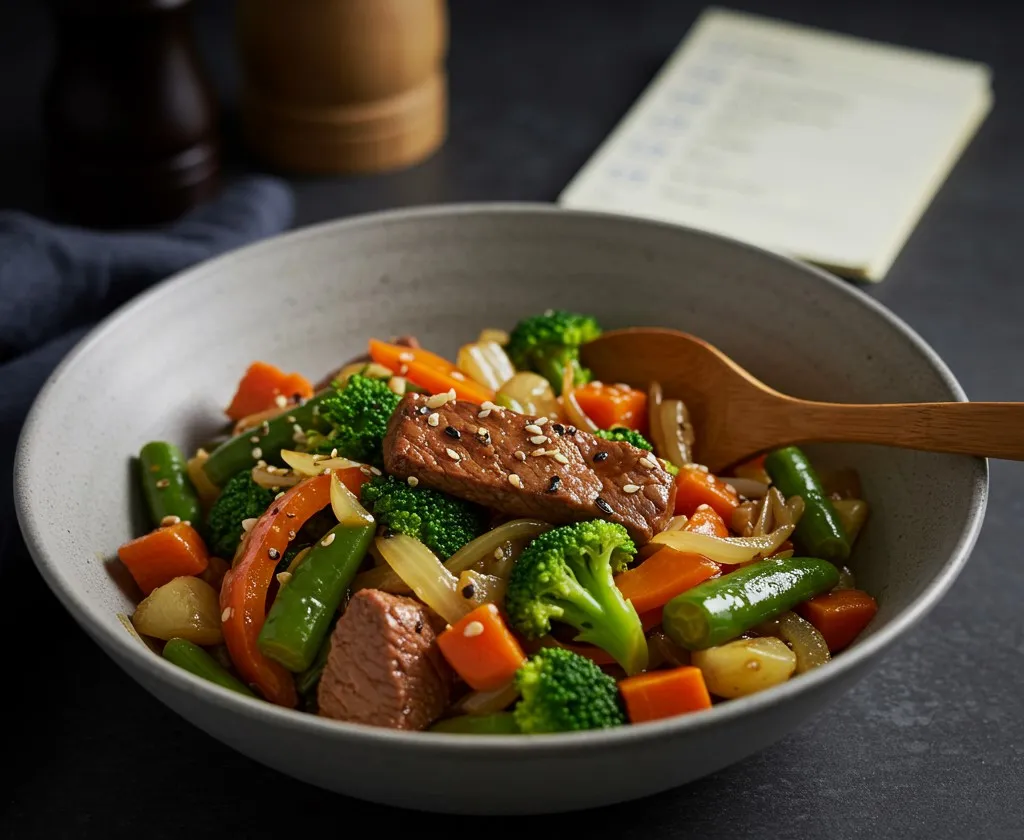
Want to turn this stir-fry into a complete meal? Adding a protein makes it even more satisfying. Here are some great options:
- Tofu (cubed and pan-fried) – A great plant-based choice that absorbs flavors well.
- Chicken (thinly sliced breast or thigh) – Cooks quickly and pairs well with the sauce.
- Shrimp (peeled and deveined) – A fast-cooking protein that adds a seafood twist.
- Beef (sirloin or flank steak, sliced thinly) – Perfect for a hearty, savory stir-fry.
Each of these proteins cooks quickly and complements the dish beautifully.
5. Best Oils for Vegetable Stir-Fry for Dinner
Since stir-frying requires high heat, choosing the right oil is crucial. Skip olive oil—it tends to smoke at high temperatures. Instead, use:
- Peanut oil – Traditional in Asian cooking and great for high-heat cooking.
- Avocado oil – A neutral-flavored option with a high smoke point.
- Sesame oil (for flavor, not for frying) – Adds an authentic, nutty aroma when drizzled at the end.
6. Serving Options
Pair your vegetable stir-fry with a side that complements its flavors:
- Steamed jasmine rice – Classic and fluffy, perfect for soaking up sauce.
- Brown rice – A fiber-rich, whole-grain alternative.
- Quinoa – A protein-packed, gluten-free option.
- Noodles (rice noodles, udon, or soba) – Adds a comforting, hearty element.
With these simple ingredients, you’re ready to make a stir-fry that’s healthy, flavorful, and incredibly easy. Let’s dive into the cooking process, one step at a time.
How to Make a Quick and Healthy Vegetable Stir-Fry for Dinner
Cooking a vegetable stir-fry is quick and simple, but a few key techniques will help you achieve the perfect balance of crisp-tender vegetables, rich flavors, and a well-coated sauce. Follow these steps for a foolproof, restaurant-quality stir-fry at home.
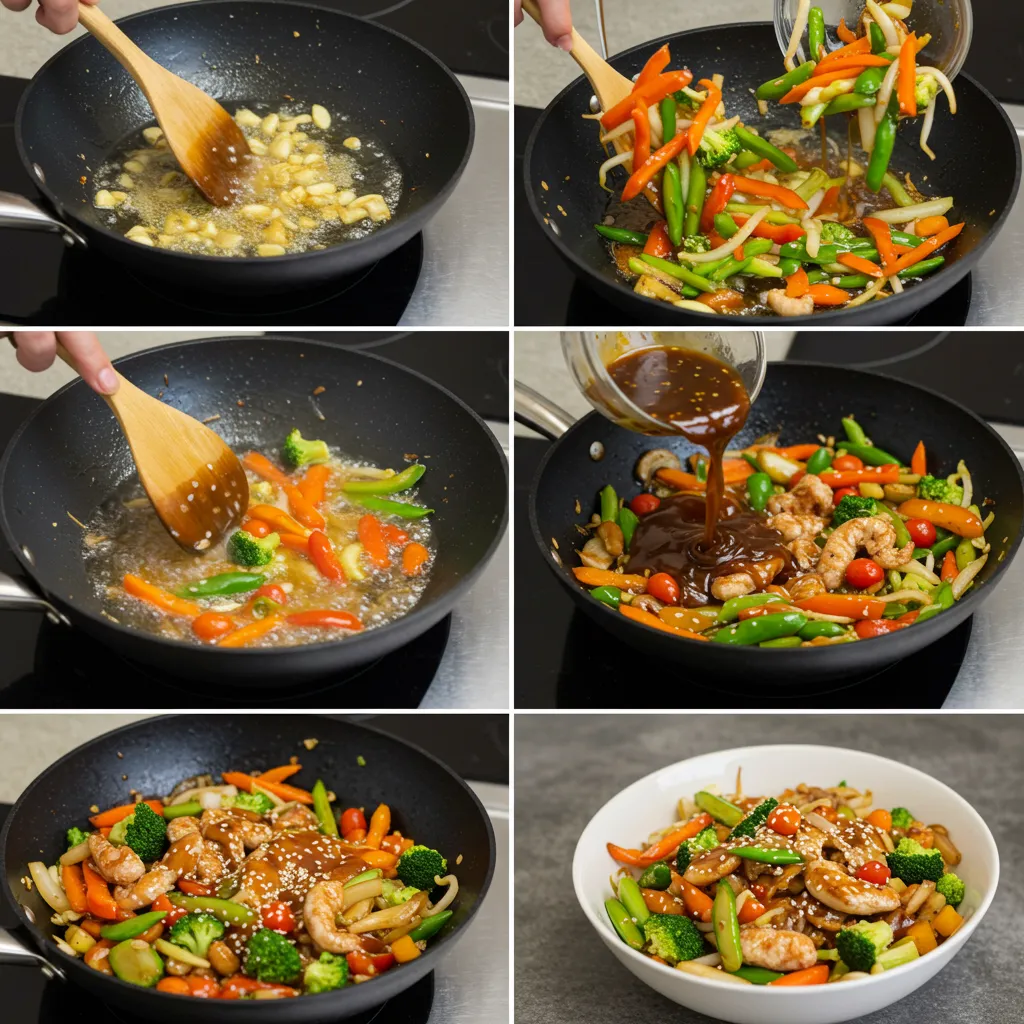
1: Prep All Ingredients Before Cooking
Stir-frying is a fast process, so it’s important to have everything ready before you turn on the heat.
- Wash and chop vegetables into even, bite-sized pieces to ensure uniform cooking.
- Mince the garlic and grate the ginger for fresh, bold flavor.
- Measure out the stir-fry sauce ingredients and mix them in a small bowl.
- Prepare your protein (if using) by slicing it thinly for quick cooking.
2: Heat the Wok or Pan
A wok is ideal for stir-frying because of its shape, but a large skillet works well too. Heat the pan over medium-high to high heat for about 1-2 minutes.
- Add 1 tablespoon of high-heat oil (peanut or avocado oil).
- Gently angle the pan to allow the oil to coat the entire surface.
A hot pan is key to achieving the signature stir-fry texture—vegetables should sear quickly without steaming.
3: Cook the Protein (If Using)
If adding chicken, tofu, shrimp, or beef, cook it first:
- Add the protein to the hot pan and sear for 2-3 minutes per side until golden brown.
- Take it out of the pan and let it rest on a plate. This prevents overcooking while the vegetables cook.
4: Stir-Fry the Vegetables
Now, it’s time to cook the vegetables. Start with the ones that take the longest to soften:
- Add the aromatics (garlic and ginger) and stir for 30 seconds until fragrant.
- Toss in firm vegetables like carrots, broccoli, and bell peppers first. Stir-fry for 2-3 minutes, keeping them moving in the pan.
- Add softer vegetables like zucchini, mushrooms, and snow peas and cook for another 2 minutes.
Vegetables should be vibrant and crisp-tender, not mushy.
5: Add the Stir-Fry Sauce
Once the vegetables are nearly done, pour in the prepared sauce.
- Stir everything together so the sauce evenly coats the ingredients.
- If using cornstarch in the sauce, it will start to thicken after about 1 minute.
- Add the cooked protein back to the pan and stir to combine.
Let everything cook for another 1-2 minutes, allowing the flavors to meld.
6: Finish and Serve
Turn off the heat and drizzle with sesame oil for extra depth of flavor.
- Top it off with sliced green onions or a sprinkle of sesame seeds.
- Enjoy right away over your choice of rice, quinoa, or noodles.
For the best taste, enjoy the stir-fry fresh, while the vegetables are still crisp and the sauce is perfectly coated.
Now that you’ve mastered the cooking process, let’s explore some pro tips and variations to customize your stir-fry even further.
Expert Tips to Perfect Your Homemade Vegetable Stir-Fry
A great vegetable stir-fry is all about technique, balance, and customization. Whether you want to enhance the flavor, adjust for dietary preferences, or experiment with different ingredients, these pro tips and variations will help you make the perfect stir-fry every time.
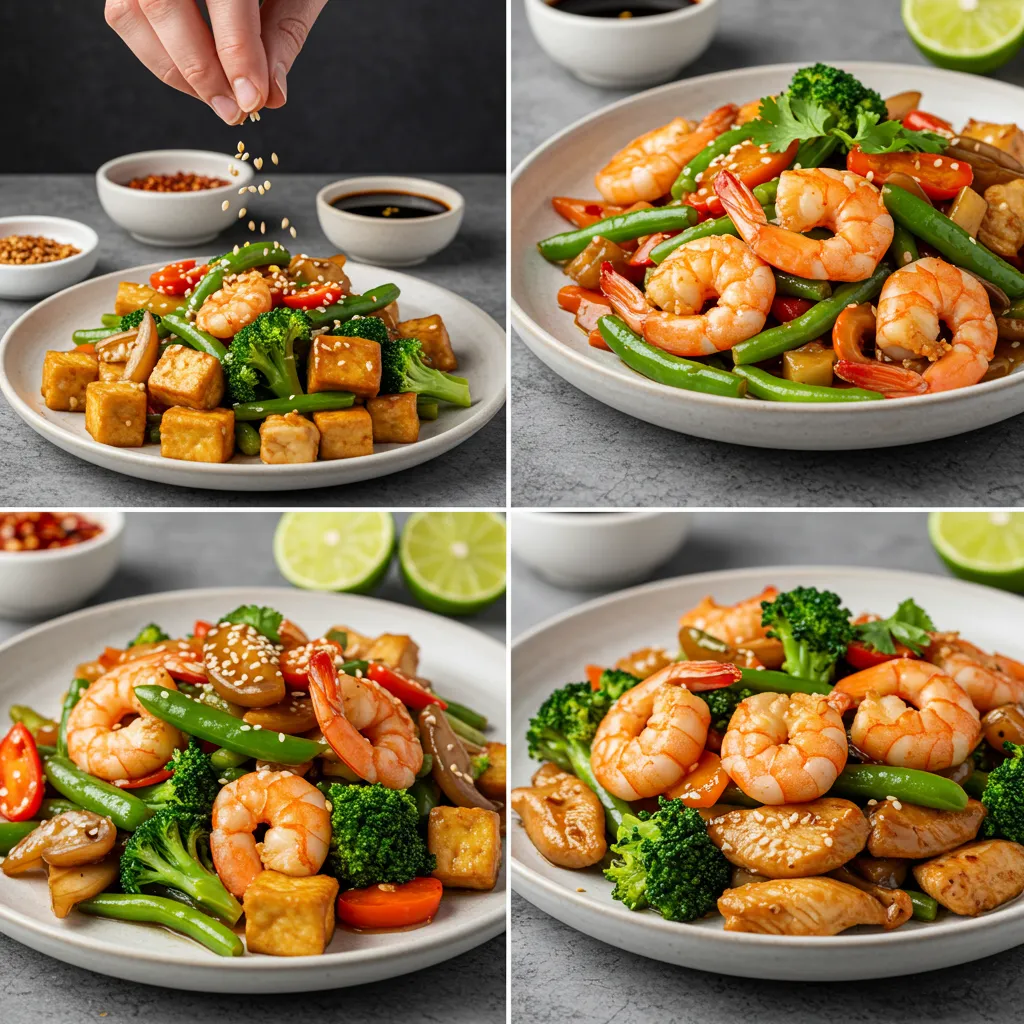
1. Pro Tips for the Best Vegetable Stir-Fry for Dinner
– Use High Heat
Cooking over medium-high to high heat ensures vegetables stay crisp-tender instead of becoming soggy. A hot pan helps them sear quickly while retaining their natural texture.
– Don’t Overcrowd the Pan
If you add too many vegetables at once, they will steam instead of sear. Cook in batches if needed to maintain the perfect texture.
– Cut Vegetables Evenly
Chop your vegetables into uniform, bite-sized pieces to ensure they cook at the same rate. Firmer vegetables like carrots and broccoli should be cut thinner to cook quickly.
– Stir Constantly
Keep the ingredients moving in the pan to prevent burning and ensure even cooking. A wok’s sloped sides make tossing easier, but a large skillet works too.
– Add Sauce at the Right Time
Pour in the stir-fry sauce once the vegetables are nearly done. This prevents them from becoming overcooked and allows the sauce to thicken properly.
– Finish with Sesame Oil
A drizzle of toasted sesame oil at the end enhances the dish with a deep, nutty aroma. Avoid cooking with it, as it burns easily.
2. Vegetable Stir-Fry for Dinner Variations to Try
Protein-Packed Options
Transform this stir-fry into a complete meal with a protein boost:
- Chicken: Use thinly sliced breast or thigh meat for a lean, flavorful addition.
- Tofu: Press and cube firm tofu, then pan-fry for a crispy texture.
- Shrimp: Quick-cooking and pairs well with garlic and ginger.
- Beef: Thin slices of flank or sirloin steak work best for a tender bite.
Dietary Modifications
Easily adapt this dish to suit different dietary needs:
- Vegan: Stick to plant-based proteins like tofu, tempeh, or chickpeas.
- To keep it gluten-free, swap soy sauce for tamari or coconut aminos.
- Low-Carb/Keto: Use zucchini noodles or cauliflower rice instead of traditional rice.
Flavor Enhancements
Elevate your stir-fry with bold, dynamic flavors:
- Spicy Kick: Add sriracha, chili flakes, or fresh chopped chili.
- Extra Umami: Mix in a spoonful of oyster sauce, hoisin sauce, or miso paste.
- Citrusy Twist: A squeeze of lime juice at the end adds brightness.
Fun Add-Ins for Texture
For more depth and crunch, try adding:
- Cashews or peanuts – A satisfying nutty crunch.
- Sesame seeds – A classic garnish for extra flavor.
- Water chestnuts – Adds a crisp, refreshing bite.
Experimenting with different ingredients keeps your stir-fry exciting and versatile. Whether you’re following a specific diet or just switching things up, these simple tweaks will help you create a dish that suits your taste.
Now that you’ve mastered the technique and flavors, let’s explore the best ways to serve and enjoy your vegetable stir-fry.
Best Ways to Serve Vegetable Stir-Fry for a Flavorful Dinner
A vegetable stir-fry is delicious on its own, but pairing it with the right sides and toppings can elevate it into a complete, satisfying meal. Whether you’re looking for a light, low-carb option or a hearty, comforting base, here are some of the best ways to serve and enjoy your stir-fry.
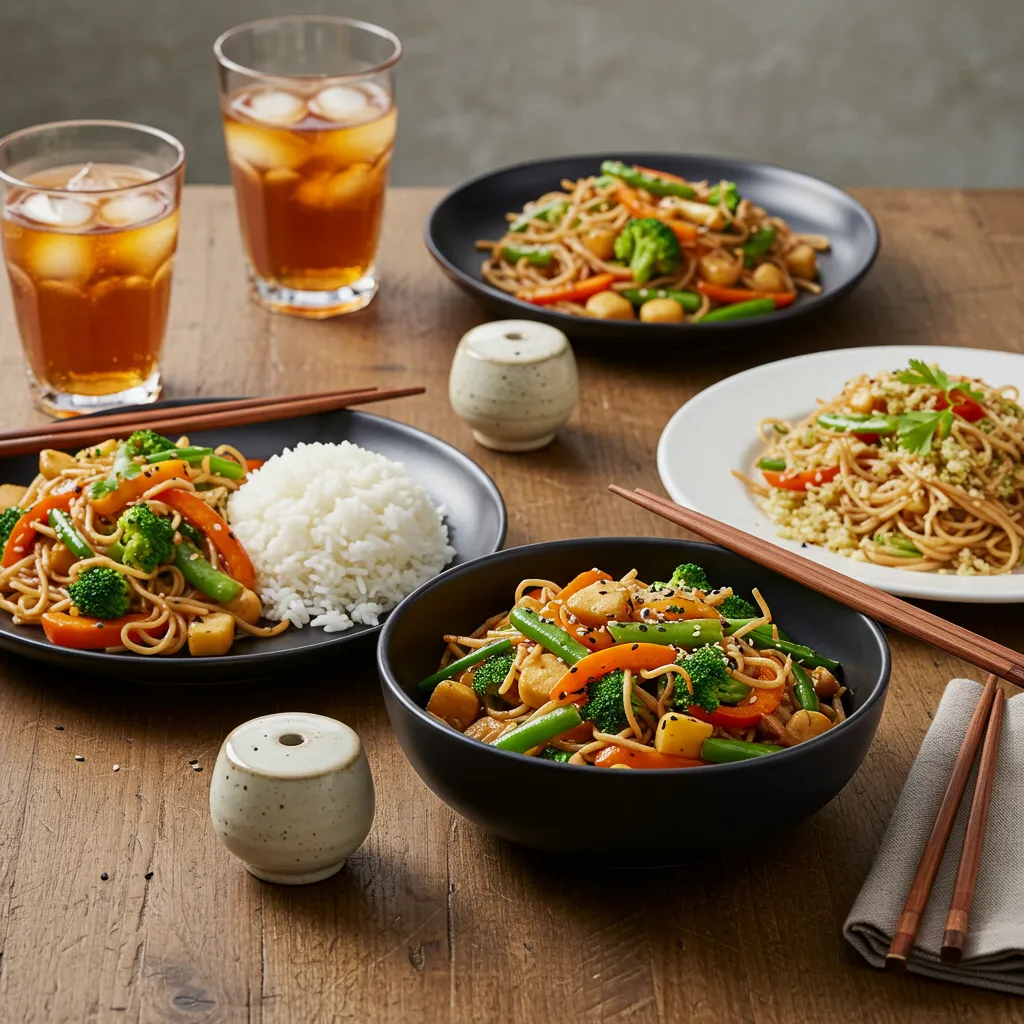
1. Classic Serving Options
– Steamed Jasmine Rice – A fluffy, slightly sticky rice that soaks up the sauce beautifully.
– Brown Rice – A fiber-rich alternative with a slightly nutty flavor.
– Quinoa – A protein-packed, gluten-free option that pairs well with stir-fried vegetables.
– Rice Noodles or Udon Noodles – Adds a comforting, chewy texture.
– Cauliflower Rice – A low-carb alternative that keeps the dish light while absorbing flavors.
2. Protein Pairings
If you didn’t add protein to the stir-fry itself, consider serving it alongside:
- Grilled or baked chicken for a lean, high-protein meal.
- Seared tofu for a plant-based option with extra texture.
- Pan-fried shrimp for a seafood twist.
- Stir-fried tempeh for a hearty, nutty flavor.
3. Garnishes for Extra Flavor
A few simple garnishes can enhance the taste and presentation of your stir-fry:
– Toasted sesame seeds – Adds a subtle crunch and nuttiness.
– Chopped green onions – Brightens up the dish with fresh flavor.
– Fresh cilantro or Thai basil – Introduces a fragrant, herbaceous note.
– Crushed peanuts or cashews – Gives a satisfying crunch and richness.
– Lime wedges – A squeeze of lime juice enhances the dish with a tangy contrast.
4. Storage and Meal Prep Tips
This stir-fry is great for meal prep and can be stored for later use. To keep it fresh:
-Cool and transfer leftovers to an airtight container, then refrigerate for up to 4 days.
– Reheat: Warm in a pan over medium heat for the best texture. Avoid microwaving for too long, as it can make the vegetables mushy.
– Freeze: If making in advance, freeze the vegetables and sauce separately for better consistency when reheated.
5. Creative Ways to Use Leftovers
Turn your leftover stir-fry into a completely new meal:
- Stir-Fry Wraps: Fill whole wheat tortillas with stir-fry and a drizzle of peanut sauce.
- Stir-Fry Fried Rice: Toss leftovers with a beaten egg and day-old rice for a quick fried rice dish.
- Stuffed Peppers: Fill bell peppers with reheated stir-fry and bake for a new twist.
With these serving ideas, you can enjoy your vegetable stir-fry in a variety of ways, making it a versatile dish for any occasion. Now, let’s wrap things up with a final recap and call to action.
Try This Easy Vegetable Stir-Fry for a Delicious Dinner
Whether you prefer it with steamed rice, noodles, or a low-carb option like cauliflower rice, this stir-fry adapts to your dietary needs. Plus, it’s an excellent way to use up leftover vegetables while creating a delicious meal in minutes.
Why You’ll Love Vegetable Stir-Fry for Dinner Again and Again:
- Fast and simple – On the table in less than 20 minutes.
- Loaded with nutrients – Packed with vitamins, fiber, and antioxidants.
- Customizable – Adjust ingredients to suit your taste and dietary preferences.
- Great for meal prep – Stays fresh for days and reheats well.
Now it’s your turn! What’s your favorite vegetable combination for stir-fry? Share your thoughts in the comments, and let’s inspire each other with new ideas. Tried this recipe? We’d love to hear what you think!
Looking for more flavorful meal ideas? Explore these related recipes:
- Steamed Chicken with Vegetables – A light and healthy dish to complement your stir-fry.
- How to Make Tomato Sauce at Home – Perfect for homemade Asian-inspired sauces.
- The Ultimate Guide to Marinating Meat – Learn how to add deep, rich flavors to your protein choices.
- Unlocking the Magic of Umami Sauce – Enhance your stir-fry with bold, savory flavors.
- Porcupine Soup – A hearty and comforting meal idea to try next.
FAQs about Vegetable Stir-Fry for Dinner
Cooking a vegetable stir-fry is simple, but you might have a few questions about technique, ingredients, and storage. Here are some of the most commonly asked questions to help you perfect your stir-fry every time.
1. Is it okay to use frozen veggies in place of fresh ones?
Yes, but with a few adjustments. Since frozen veggies hold extra moisture, thaw them and blot dry for best results. Stir-fry them over high heat to prevent sogginess.
2. How Do I Keep My Vegetables Crisp?
To maintain that crisp-tender texture:
Crank up the heat to sauté vegetables fast and keep them crisp.
– Do not overcrowd the pan, or they will steam instead of sear.
– Cut vegetables into even-sized pieces for uniform cooking.
Toss in delicate veggies toward the end to avoid overcooking.
3. Is it possible to prepare this stir-fry in advance?
Yes, stir-fry is great for meal prep. To keep it fresh:
– Keep your stir-fry fresh by storing it in an airtight container in the fridge for up to 4 days.
– Keep leftover stir-fry in a sealed container in the refrigerator for up to 4 days.
– ansfer the dish to an airtight container and refrigerate for safe storage up to 4 days.
4. What’s the Best Protein to Add?
You can customize this dish with various protein options:
– Chicken – Slice thinly for quick, even cooking.
– Tofu – Press and pan-fry for a crispy texture.
– Shrimp – Quick to cook, ready in minutes.
– Beef – Use flank or sirloin steak, cut against the grain.
5. Can I Make This Recipe Gluten-Free?
Yes! For a gluten-free option, replace soy sauce with tamari or coconut aminos.. Also, check your other sauce ingredients, like hoisin or oyster sauce, for hidden gluten.
6. What Can I Serve with Stir-Fry?
– Pair it with steamed or brown rice for a timeless combo.
– Quinoa for a protein-rich option.
– Opt for rice noodles or udon if you’re craving something more filling.
– Cauliflower rice for a low-carb alternative.
7. Can I Freeze Stir-Fry?
While you can freeze it, the vegetables may lose their crisp texture.Planning to freeze? Keep the sauce separate and add freshly cooked veggies when reheating.
8. What can I do to boost the flavor of my Vegetable Stir-Fry for Dinner?
– Add fresh garlic and ginger for an aromatic boost.
– Finish with toasted sesame oil to add rich, nutty flavor.
– A touch of rice vinegar or lime juice adds a fresh, tangy lift.
– Try chili flakes, sriracha, or fresh chilies for heat.
These FAQs cover the most common concerns, ensuring your vegetable stir-fry turns out perfect every time. Got questions? Drop them in the comments below!

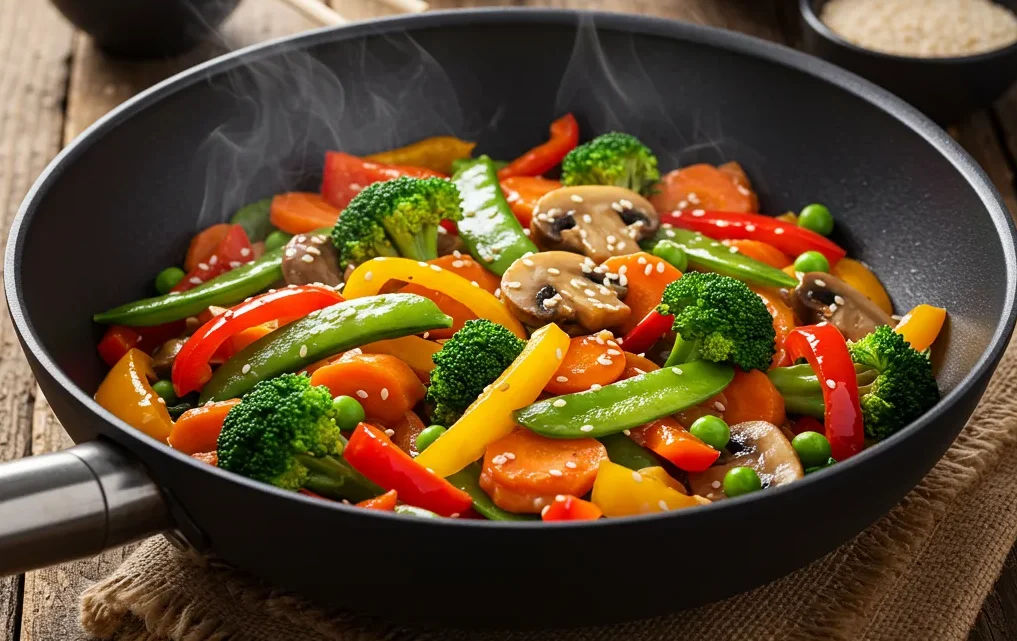
3 thoughts on “Vegetable Stir-Fry for Dinner: A Healthy, Quick, and Delicious Meal”